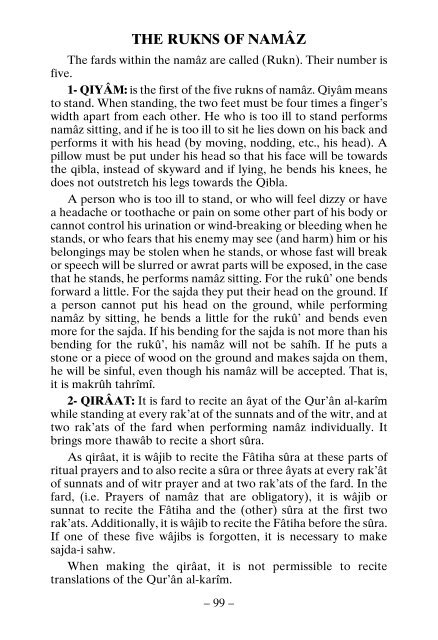Book of Namaz
You also want an ePaper? Increase the reach of your titles
YUMPU automatically turns print PDFs into web optimized ePapers that Google loves.
THE RUKNS OF NAMÂZ<br />
The fards within the namâz are called (Rukn). Their number is<br />
five.<br />
1- QIYÂM: is the first <strong>of</strong> the five rukns <strong>of</strong> namâz. Qiyâm means<br />
to stand. When standing, the two feet must be four times a finger’s<br />
width apart from each other. He who is too ill to stand performs<br />
namâz sitting, and if he is too ill to sit he lies down on his back and<br />
performs it with his head (by moving, nodding, etc., his head). A<br />
pillow must be put under his head so that his face will be towards<br />
the qibla, instead <strong>of</strong> skyward and if lying, he bends his knees, he<br />
does not outstretch his legs towards the Qibla.<br />
A person who is too ill to stand, or who will feel dizzy or have<br />
a headache or toothache or pain on some other part <strong>of</strong> his body or<br />
cannot control his urination or wind-breaking or bleeding when he<br />
stands, or who fears that his enemy may see (and harm) him or his<br />
belongings may be stolen when he stands, or whose fast will break<br />
or speech will be slurred or awrat parts will be exposed, in the case<br />
that he stands, he performs namâz sitting. For the rukû’ one bends<br />
forward a little. For the sajda they put their head on the ground. If<br />
a person cannot put his head on the ground, while performing<br />
namâz by sitting, he bends a little for the rukû’ and bends even<br />
more for the sajda. If his bending for the sajda is not more than his<br />
bending for the rukû’, his namâz will not be sahîh. If he puts a<br />
stone or a piece <strong>of</strong> wood on the ground and makes sajda on them,<br />
he will be sinful, even though his namâz will be accepted. That is,<br />
it is makrûh tahrîmî.<br />
2- QIRÂAT: It is fard to recite an âyat <strong>of</strong> the Qur’ân al-karîm<br />
while standing at every rak’at <strong>of</strong> the sunnats and <strong>of</strong> the witr, and at<br />
two rak’ats <strong>of</strong> the fard when performing namâz individually. It<br />
brings more thawâb to recite a short sûra.<br />
As qirâat, it is wâjib to recite the Fâtiha sûra at these parts <strong>of</strong><br />
ritual prayers and to also recite a sûra or three âyats at every rak’ât<br />
<strong>of</strong> sunnats and <strong>of</strong> witr prayer and at two rak’ats <strong>of</strong> the fard. In the<br />
fard, (i.e. Prayers <strong>of</strong> namâz that are obligatory), it is wâjib or<br />
sunnat to recite the Fâtiha and the (other) sûra at the first two<br />
rak’ats. Additionally, it is wâjib to recite the Fâtiha before the sûra.<br />
If one <strong>of</strong> these five wâjibs is forgotten, it is necessary to make<br />
sajda-i sahw.<br />
When making the qirâat, it is not permissible to recite<br />
translations <strong>of</strong> the Qur’ân al-karîm.<br />
– 99 –

















